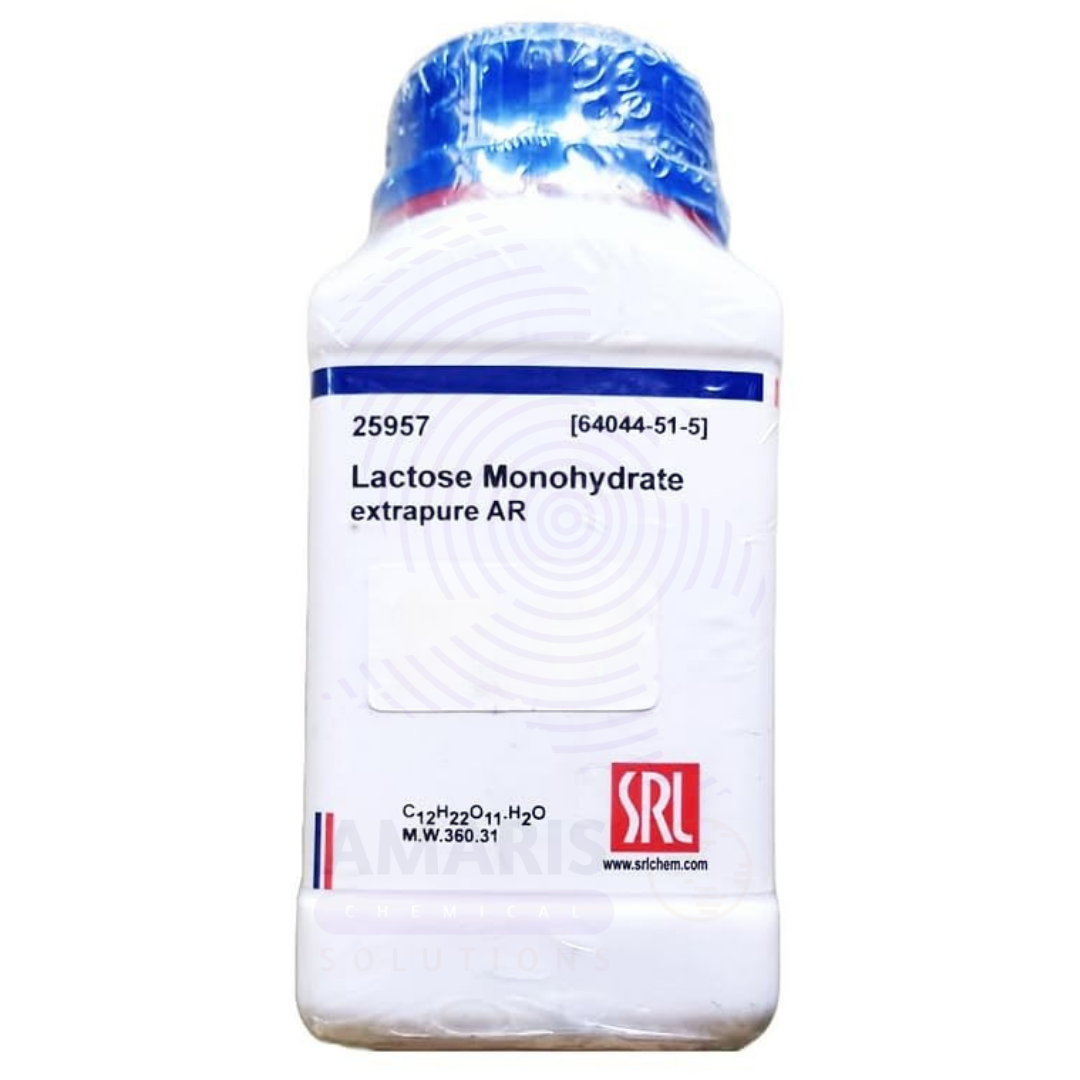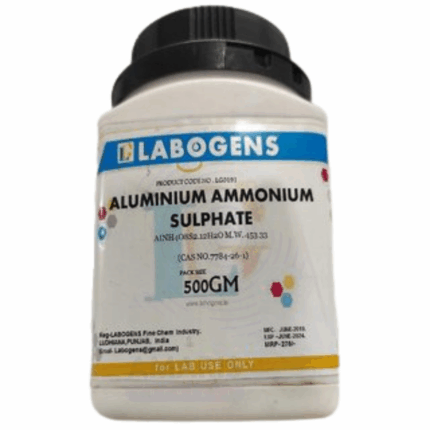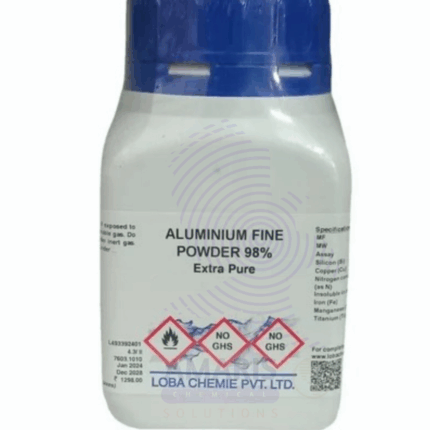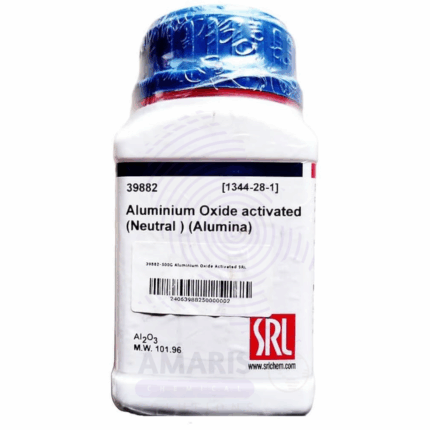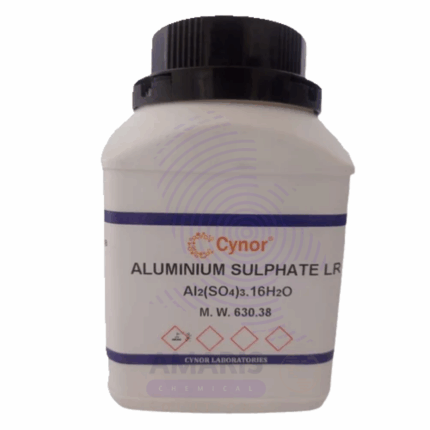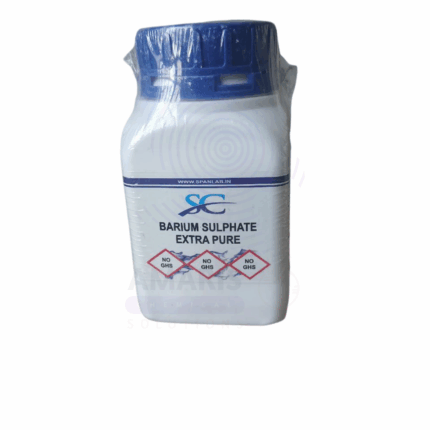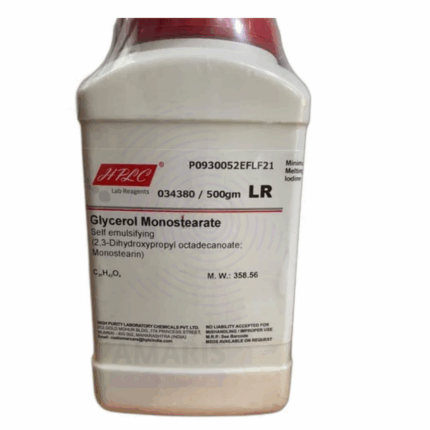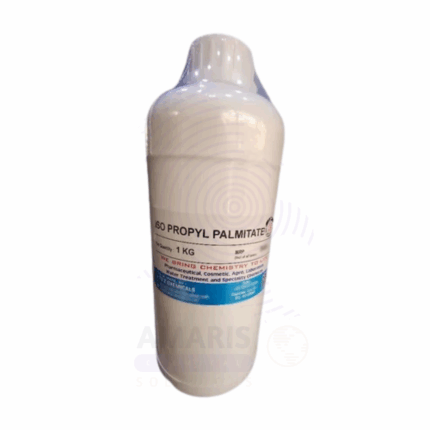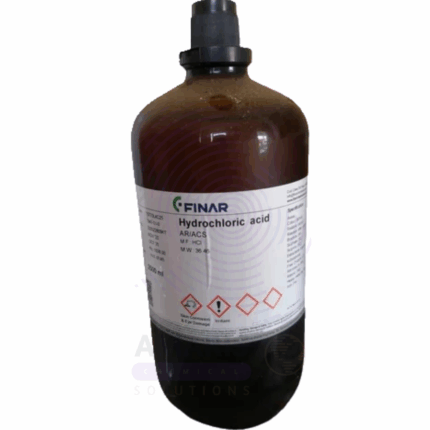
Lactose Monohydrate Extra Pure
$ 17.40 Original price was: $ 17.40.$ 17.32Current price is: $ 17.32.
Lactose Monohydrate Extra Pure is a high-purity, crystalline disaccharide composed of glucose and galactose, containing one molecule of water per lactose unit. It is widely used in laboratory settings for biochemical research, nutrient media preparation, and as an excipient in pharmaceutical formulation studies. Its consistent solubility and stability make it ideal for carbohydrate analysis, fermentation experiments, and as a mild reducing sugar in analytical reactions. The extra pure grade ensures low impurity levels, supporting accurate and reproducible results in sensitive scientific applications. Proper storage in a cool, dry environment is essential to maintain its crystalline form and prevent caking.
Lactose Monohydrate Extra Pure
Primary Uses
- Pharmaceutical Excipient:
Widely used as a diluent or filler in tablet and capsule formulations due to its stability, compressibility, and low reactivity. - Microbiological Culture Media Component:
Included as a carbohydrate source in various culture media (e.g., MacConkey agar) to support the growth and differentiation of microorganisms. - Calibration Standard in Analytical Chemistry:
Utilized as a reference compound or standard in HPLC, IR, and NMR for method development and validation, especially in pharmaceutical analysis.
Secondary Uses
- Carrier for Dry Powder Inhalation Studies:
Employed as a carrier substance in dry powder inhaler (DPI) formulations during aerosol and respiratory drug delivery research. - Research on Carbohydrate Metabolism:
Serves as a model for disaccharide sugar in biochemical studies of enzyme activity (e.g., lactase) and lactose intolerance mechanisms. - Lyophilization (Freeze Drying) Support:
Used as a cryoprotectant or bulking agent in the freeze-drying of biologicals and pharmaceuticals.
| PACK SIZE |
500 grams Plastic Tin |
|---|
1. Basic Identification Attributes
- Chemical Name: Lactose Monohydrate
- Synonyms: Milk sugar; β-D-Galactopyranosyl-(1→4)-D-glucose monohydrate
- Chemical Formula: C₁₂H₂₂O₁₁·H₂O
- CAS Number: 64044-51-5
- Molecular Weight: 360.31 g/mol
- Grade: Extra Pure (suitable for analytical and laboratory use)
- Appearance: White crystalline powder
- Odor: Odorless
- Solubility: Soluble in water, practically insoluble in alcohol
- Taste: Mildly sweet
2. Safety & Hazard Attributes
- GHS Classification: Not classified as hazardous
- Hazard Statements: None under normal laboratory handling
- Precautionary Statements:
- Avoid inhalation of dust
- Use in a well-ventilated area
- Avoid contact with eyes
- Personal Protective Equipment (PPE):
- Lab coat
- Safety goggles
- Dust mask or respirator if powder is airborne
- Gloves (nitrile or latex)
- First Aid Measures:
- Inhalation: Move to fresh air; seek attention if symptoms persist
- Skin Contact: Wash with soap and water
- Eye Contact: Rinse with plenty of water for at least 15 minutes
- Ingestion: Rinse mouth; non-toxic but seek medical advice if necessary
- Fire Hazards:
- Not highly flammable, but dust may form explosive mixtures with air
- Extinguishing Media: Use water spray, dry chemical, CO₂, or foam
- Special Notes: Handle powders with caution to prevent airborne dispersion
3. Storage & Handling Attributes
- Storage Conditions:
- Store in a tightly sealed container
- Keep in a cool, dry place
- Protect from moisture and strong oxidizing agents
- Handling Tips:
- Avoid generating dust
- Use clean, dry utensils to avoid contamination
4. Laboratory Applications
- Primary Uses:
- As a carrier or diluent in pharmaceutical formulations
- Standard in biochemical assays and enzyme reactions
- Used in microbiology culture media
- Excipient in tablet and capsule production
- Secondary Uses:
- Used in food analysis and nutritional studies
- Research in carbohydrate metabolism and lactose intolerance
- Calibration and quality control testing in pharmaceutical labs
SAFETY PRECAUTIONS
Personal Protective Equipment (PPE):
- Wear a lab coat, protective goggles, and nitrile gloves.
- Use a dust mask if airborne powder is generated.
- Ensure good ventilation or use under a fume hood.
Handling:
- Avoid creating or inhaling dust.
- Avoid contact with skin, eyes, and clothing.
- Wash hands thoroughly after handling.
- Handle in accordance with good laboratory hygiene practices.
Storage:
- Store in a cool, dry, and well-ventilated place.
- Keep the container tightly closed.
- Protect from moisture and incompatible substances like strong oxidizers.
FIRST AID MEASURES
Inhalation:
- Move the affected person to fresh air.
- If breathing is difficult, seek medical attention.
Skin Contact:
- Wash skin with soap and water.
- Remove contaminated clothing.
- Seek medical attention if irritation develops.
Eye Contact:
- Rinse cautiously with water for several minutes.
- Remove contact lenses if present and easy to do.
- Continue rinsing and get medical advice if irritation persists.
Ingestion:
- Rinse mouth with water.
- Drink water if the person is conscious.
- Seek medical advice if symptoms occur.
FIRE FIGHTING MEASURES
Flammability:
- Not highly flammable but can form explosive dust-air mixtures.
Extinguishing Media:
- Use water spray, dry chemical powder, or CO₂.
- Avoid high-pressure water streams that may disperse dust.
Hazardous Combustion Products:
- May produce carbon monoxide and carbon dioxide when burned.
Firefighter Protection:
- Use self-contained breathing apparatus (SCBA).
- Wear full protective gear.
- Avoid inhalation of combustion gases or dust.


 Preservatives(food)
Preservatives(food) Flavor Enhancers
Flavor Enhancers Acidulants
Acidulants Sweeteners
Sweeteners Antioxidants
Antioxidants Colorants(food)
Colorants(food) Nutraceutical Ingredients (food)
Nutraceutical Ingredients (food) Nutrient Supplements
Nutrient Supplements Emulsifiers
Emulsifiers
 Collectors
Collectors Dust Suppressants
Dust Suppressants Explosives and Blasting Agents
Explosives and Blasting Agents Flocculants and Coagulants
Flocculants and Coagulants Frothers
Frothers Leaching Agents
Leaching Agents pH Modifiers
pH Modifiers Precious Metal Extraction Agents
Precious Metal Extraction Agents
 Antioxidants(plastic)
Antioxidants(plastic) Colorants (Pigments, Dyes)
Colorants (Pigments, Dyes) Fillers and Reinforcements
Fillers and Reinforcements Flame Retardants
Flame Retardants Monomers
Monomers Plasticizers
Plasticizers Polymerization Initiators
Polymerization Initiators Stabilizers (UV, Heat)
Stabilizers (UV, Heat)
 Antifoaming Agents
Antifoaming Agents Chelating Agents
Chelating Agents Coagulants and Flocculants
Coagulants and Flocculants Corrosion Inhibitors
Corrosion Inhibitors Disinfectants and Biocides
Disinfectants and Biocides Oxidizing Agents
Oxidizing Agents pH Adjusters
pH Adjusters Scale Inhibitors( water)
Scale Inhibitors( water)
 Antioxidants(cosmetic)
Antioxidants(cosmetic) Emollients
Emollients Fragrances and Essential Oils
Fragrances and Essential Oils Humectants
Humectants Preservatives
Preservatives Surfactants(cosmetic)
Surfactants(cosmetic) Thickeners
Thickeners UV Filters
UV Filters
 Fertilizers
Fertilizers Soil Conditioners
Soil Conditioners Plant Growth Regulators
Plant Growth Regulators Animal Feed Additives
Animal Feed Additives Biostimulants
Biostimulants Pesticides (Herbicides, Insecticides, Fungicides)
Pesticides (Herbicides, Insecticides, Fungicides)
 Active Pharmaceutical Ingredients (APIs)
Active Pharmaceutical Ingredients (APIs) Excipients
Excipients Solvents(pharmaceutical)
Solvents(pharmaceutical) Antibiotics
Antibiotics Antiseptics and Disinfectants
Antiseptics and Disinfectants Vaccine Adjuvants
Vaccine Adjuvants Nutraceutical Ingredients (pharmaceutical)
Nutraceutical Ingredients (pharmaceutical) Analgesics & Antipyretics
Analgesics & Antipyretics
 Analytical Reagents
Analytical Reagents Solvents(lab)
Solvents(lab) Chromatography Chemicals
Chromatography Chemicals Spectroscopy Reagents
Spectroscopy Reagents microbiology-and-cell-culture-reagents
microbiology-and-cell-culture-reagents Molecular Biology Reagents
Molecular Biology Reagents Biochemical Reagents
Biochemical Reagents Inorganic and Organic Standards
Inorganic and Organic Standards Laboratory Safety Chemicals
Laboratory Safety Chemicals Specialty Laboratory Chemicals(Special Laboratory Equipment)
Specialty Laboratory Chemicals(Special Laboratory Equipment)
 Demulsifiers
Demulsifiers Hydraulic Fracturing Fluids
Hydraulic Fracturing Fluids Scale Inhibitors(oil)
Scale Inhibitors(oil) Surfactants(oil)
Surfactants(oil) Drilling Fluids
Drilling Fluids
 Dyes and Pigments
Dyes and Pigments Bleaching Agents
Bleaching Agents Softening Agents
Softening Agents Finishing Agents
Finishing Agents Antistatic Agents
Antistatic Agents
 Admixtures
Admixtures Waterproofing Agents
Waterproofing Agents Sealants and Adhesives
Sealants and Adhesives Curing Compounds
Curing Compounds Concrete Repair Chemicals
Concrete Repair Chemicals Anti-Corrosion Coatings
Anti-Corrosion Coatings
 Surfactants(cleaning)
Surfactants(cleaning) Builders
Builders Enzymes
Enzymes Solvents (Cleaning)
Solvents (Cleaning) Fragrances
Fragrances
 Electronic Chemicals
Electronic Chemicals Catalysts
Catalysts Lubricants
Lubricants Photographic Chemicals
Photographic Chemicals Refrigerants
Refrigerants Automotive chemicals
Automotive chemicals Pyrotechnic Chemicals
Pyrotechnic Chemicals
 Biodegradable Surfactants
Biodegradable Surfactants Bio-based Solvents
Bio-based Solvents Renewable Polymers
Renewable Polymers Carbon Capture Chemicals
Carbon Capture Chemicals Wastewater Treatment Chemicals
Wastewater Treatment Chemicals
 Pigments
Pigments Solvents(paint)
Solvents(paint) Specialty Coatings
Specialty Coatings Binders/Resins
Binders/Resins Additives
Additives Driers
Driers Anti-Corrosion Agents
Anti-Corrosion Agents Functional Coatings
Functional Coatings Application-Specific Coatings
Application-Specific Coatings
 Fresh Herbs
Fresh Herbs Ground Spices
Ground Spices Whole Spices
Whole Spices Spice Blends
Spice Blends Dried Herbs
Dried Herbs
 Leavening Agents
Leavening Agents Dough Conditioners
Dough Conditioners Flour Treatments
Flour Treatments Fat Replacers
Fat Replacers Decoratives
Decoratives Preservatives(baking)
Preservatives(baking)
 Plasticizers & Softeners
Plasticizers & Softeners Reinforcing Agents
Reinforcing Agents Adhesion Promoters
Adhesion Promoters Vulcanizing Agents
Vulcanizing Agents Antidegradants
Antidegradants Blowing Agents
Blowing Agents Fillers & Extenders
Fillers & Extenders Accelerators & Retarders
Accelerators & Retarders